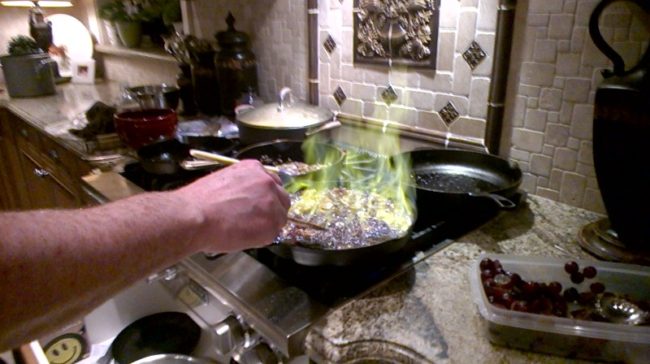
Steak au Poivre, Sautéed Grapes, Cognac Sauce
It’s a pleasure to think of Rupert, with his extraordinary hallucinations, experiencing complex flavors for the first time—and there are plenty of opportunities in the novel.
One meal mentioned in Light Sonata is steak au poivre, which means simply pepper steak. It has a long, but uncertain history, and has many versions.
Here is my own version:
Ingredients
for broth
-
- 5 pounds beef marrow bones
- 1 roasted chicken carcass (optional)
- 2 medium unpeeled carrots, cut into 2-inch pieces
- 1 medium leek, cut length-wise, trimmed ends, rinsed well, cut into 2-inch pieces
- 1 large onion, quartered
- 6 garlic cloves, peeled
- 2 celery stalks, cut into 2-inch pieces
- 4 bay leaves
- a few sprigs of fresh thyme
- 2 tablespoons whole black peppercorns
for steaks
-
- 2 NY Strip steaks, 1 pound each, 1 1/2 inch thick
- Sea salt (coarse grain)
- 3-4 tablespoons whole black peppercorns
- 2 1/2 cups red seedless grapes, halved
- 2-3 minced shallots (about a half cup)
- 2 1/2 cups of the broth recipe
- 1 cup dry red wine
- 1/3 cup cognac
- 3 tablespoons vegetable oil
- 2 tablespoons unsalted butter
1. Preheat oven to 450°F.
Make the broth
2. Place bones on a sheet pan. Place celery, carrots, leek, onion, and garlic on another sheet pan. Roast for 20 minutes. Toss vegetables and flip marrow bones and continue to roast until deeply browned, about 20 more minutes.
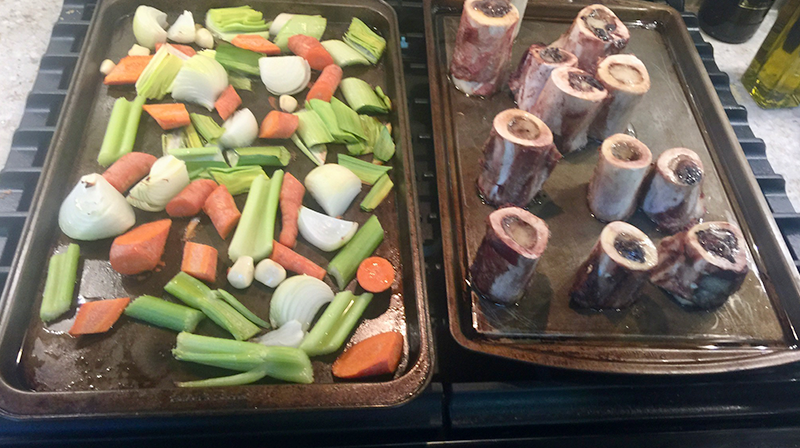
3. Place roasted vegetables, chicken, and marrow bones into a 6-quart stockpot (or a large slow cooker) and cover with water (about 12 cups of water).
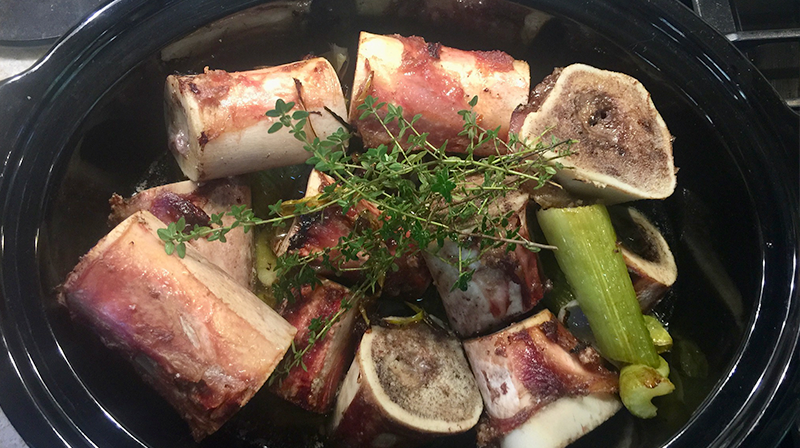
Deglaze the sheet pans with just enough water to loosen the brown bits and add the juices from the pans to the pot.
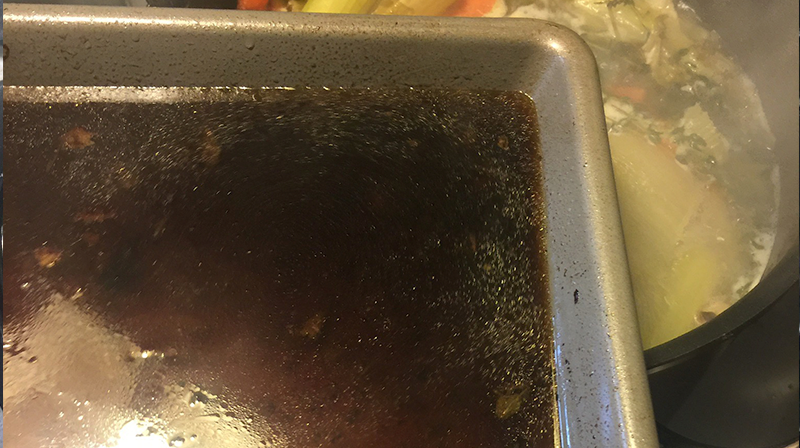
Add bay leaves and peppercorns.
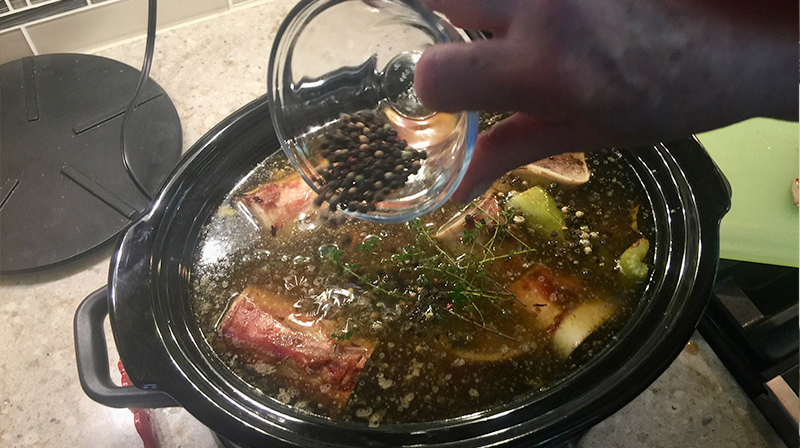
4. Cover the pot and bring to a gentle boil. Reduce heat to low and simmer with lid slightly ajar, skimming off foam and excess fat occasionally, for at least 8 hours. The longer it simmers, the better it will be, so you can also put it in the refrigerator overnight and cook several more hours the next day.
5. When finished, remove from heat. Strain broth using a fine-mesh sieve and discard bones and vegetables. Let the broth cool enough to put in the refrigerator. When chilled, discard the layer of fat that rises to the top of the broth.
Prepare the steaks.
1. Bring steaks to room temperature.
2. Dry brine the steaks.
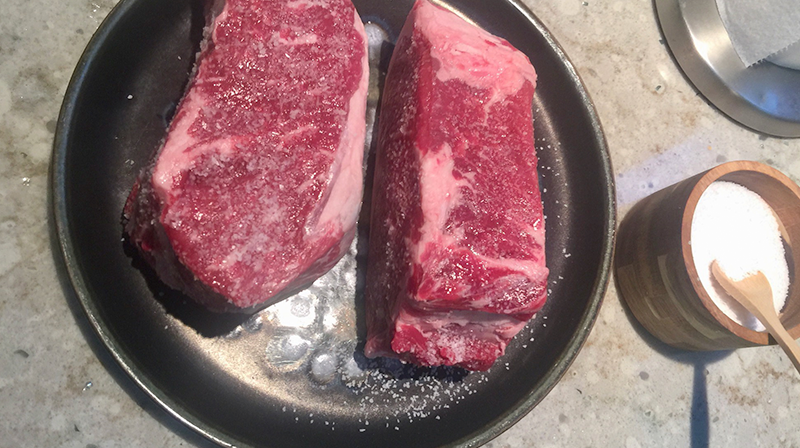
Coat both sides of the steaks with sea salt (see tips on dry brining steaks) and let sit for at least 45 minutes before cooking, or up to three days, uncovered in a rimmed baking sheet, in the refrigerator.
3. Put broth and wine in a small pot and simmer to reduce to 3/4 cup.
4. Rinse steaks and pat very dry.
As J. Kenji Lopez-Alt says in The Food Lab: Better home cooking through science:
“A wet steak will not brown properly, as energy from the pan will go into evaporating the excess moisture rather than browning the steak properly. Salting your steak and letting it rest will draw out some moisture at first, but eventually the muscle fibers break down, and that moisture will be sucked back into the meat leaving you with a well-seasoned, perfectly dry surface.”
4. Coat sides of steaks with cracked peppercorns.
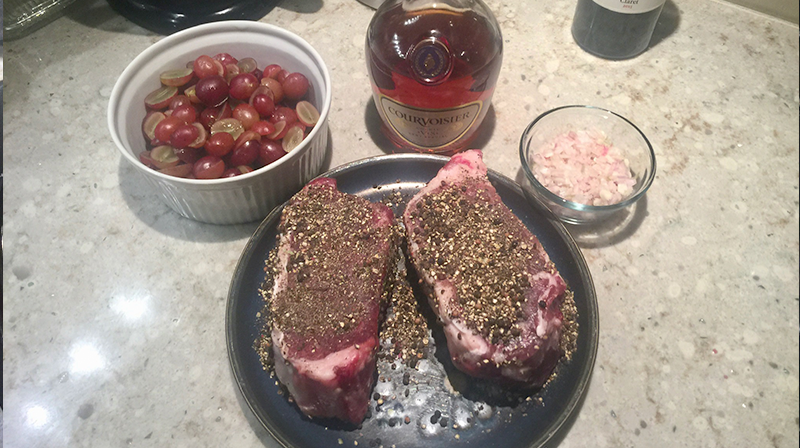
You need large pieces of cracked pepper, which only a few electric pepper mills can produce on their coarsest grind. If you do not own one of those specialty mills, spread 3-4 tablespoons of whole peppercorns over a flat surface and, pressing down heavily, rock the bottom of the heavy skillet over them until every grain is crushed.
When all peppercorns are cracked, press the steaks down on them. (You may need to also press the peppercorns into the meat with your fingers.)
Flip and coat the other side with cracked pepper. When you finish, both sides of the steak should appear completely black with cracked pepper.
5. Coat the bottom of a cast-iron skillet with vegetable oil and heat until oil begins to smoke. (Olive oil is not recommended because of its flavor when combined with these ingredients and because of its low smoking point).
Place steaks in the hot oil and listen for a nice sizzle.
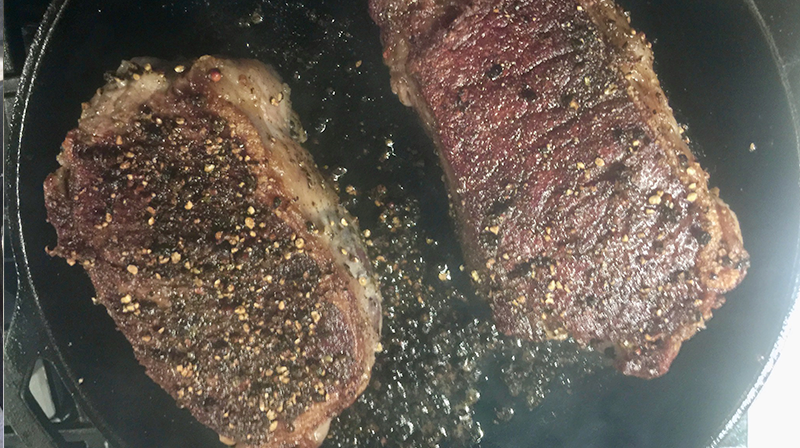
6. Using tongs, flip the steak frequently.
Some chefs argue that you should leave one side on the oil for a long time before flipping. However, I’ve found the best results by flipping about every 30 seconds, particularly with thick steaks.
If the oil starts to smoke or burn, reduce the heat.
7. Manage the temperature.
For normal-sized steaks, an inch-thick or so, start with hot, hot oil. For thicker steaks, start with a more moderate temperature.
Your goal is to perfectly brown the outside while the steak reaches its target internal temperature. (See below.)
If you are adapting this recipe to cook more than two steaks, be careful not to crowd the pan. Too many cold steaks can cool down the hottest pan too fast. Make sure your steaks have at least an inch of room around them on all sides. When cooking a large number of steaks, cook in batches, reheating the skillet before each batch, or use multiple skillets.
Then, using an instant-read thermometer, test the internal temperature to your target temperature.
120 degrees F for rare
130 degrees F for medium-rare
140 degrees F for medium
150 degrees F for medium-well
160 degrees F for well-done
8. Now sear each edge of the steak.
Prop up each steak on its side for about 30 seconds. Repeat for each side).
9. Remove the steaks and let them rest.
Cover the steaks with tented foil and let them sit for no less than 10 minutes. You will need more than 10 minutes to make the sauce, so you may need to put the steaks in a warming oven.
10. Make the sauce.
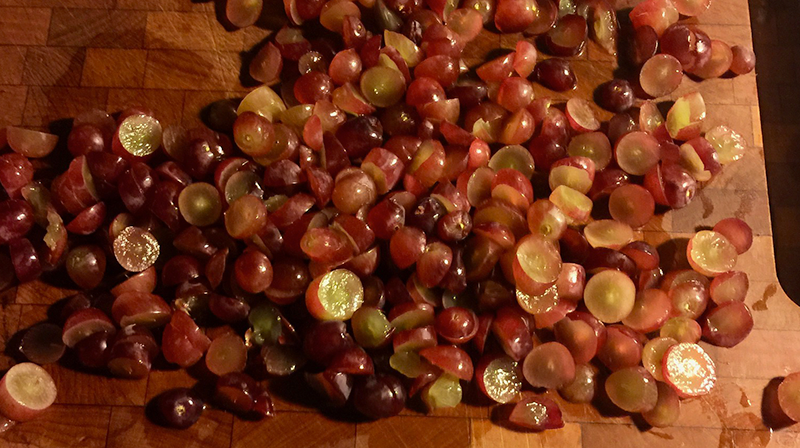
Remove most of the fat and peppercorns from the pan (you want to do this because some of the peppercorns will be burned), but leave the browned bits from the steak.
Deglaze the skillet first by adding 1 tablespoon of butter to the pan. Stir up browned bits.
Add the grapes and stir constantly until grapes take on a meaty flavor (about 13-15 minutes).
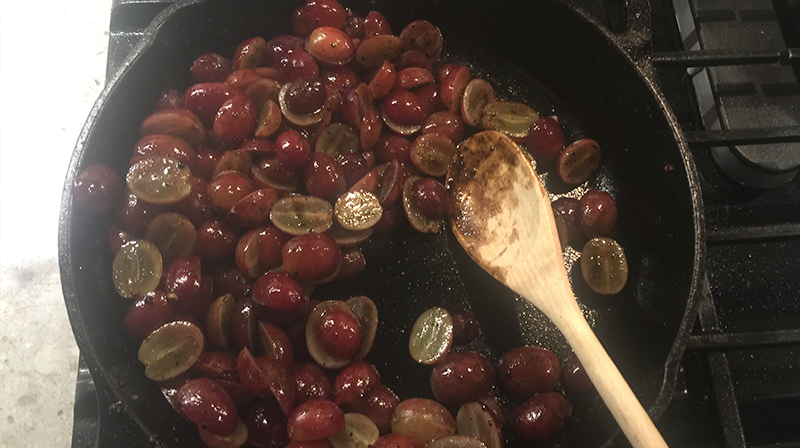
Stir in chopped shallots and cook for 4-5 minutes. While working, scrape the bottom of the pan all over to make sure that nothing sticks.

Stir in reduced wine-broth.
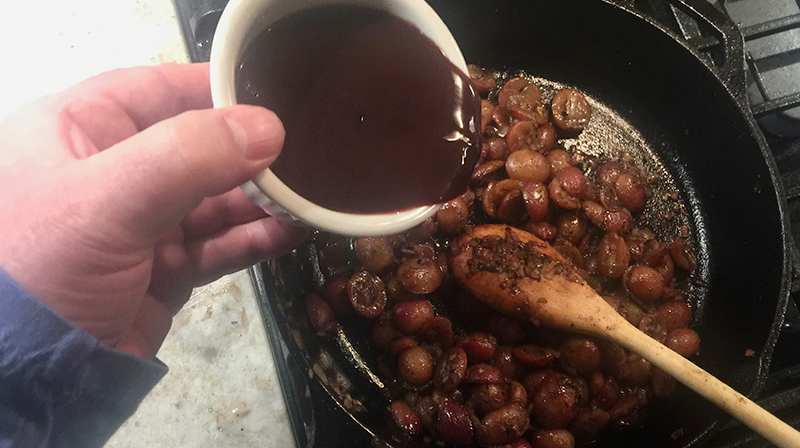
Stir in cognac and light with a long match to burn off the alcohol.
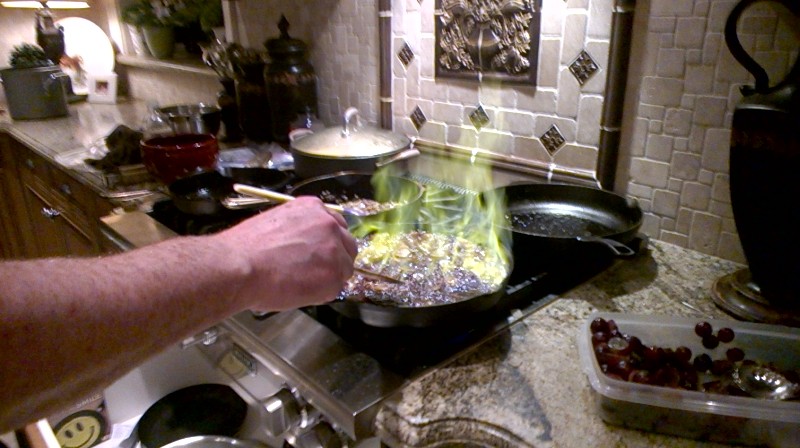
Keep stirring and reduce until sauce is thick, about three to five minutes.
11. Plate your dish.
Cut the steaks into slices and arrange them on a plate.
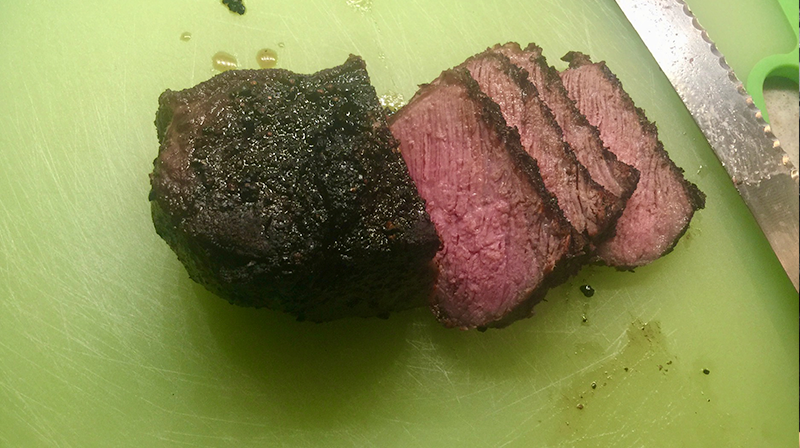
Pour cognac, wine-broth, and grape sauce over steaks and serve.
Enjoy.
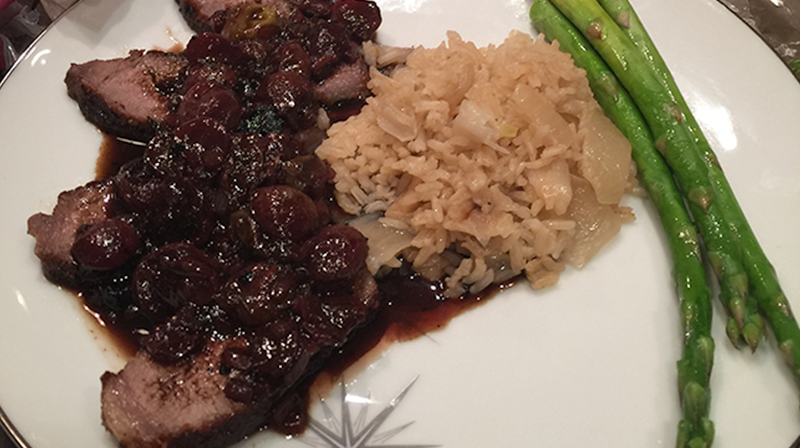
Steak Au Poivre Recipe With Sautéed Grapes In Cognac Sauce
It's a pleasure to think of how Robert would experience outrageously complex flavors hitting his tongue—and in the novel, this is one great recipe.
Type: main dish
Cuisine: French
Keywords: steak au poivre, NY strip, classy meal
Recipe Yield: 4 servings
Preparation Time: PT48H
Cooking Time: PT2H
Total Time: PT3H
Recipe Ingredients:
5


That recipe sounds absolutely wonderful.
You have made me VERY HUNGRY! Your details draws me right into the process of making it, the tactile sensation of preparing the ingredients and certainly the piece de resistance THE DELIGHTFUL SMELL that is intoxicating and inviting! BRAVO!